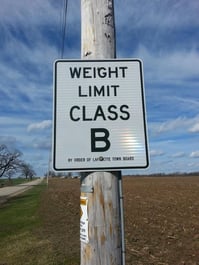
Restrictive vs. Prohibitive Signage
Restrictive Signs are those (Like a Class B Road sign) that restrict access, but do not prohibit travel under certain parameters. In Wisconsin, a Class B road can only be used as a through route when your weights do not exceed 60% of that which is normally allowed for your vehicle. This includes single axle weights, axle groupings, and gross weight. However, if your pick-up or delivery point maintains an entrance on the posted road, you are allowed to proceed and disregard the posting. Class B postings are generally long term, year round restrictions and meant to limit the use of county, town, and municipal roads for reasons of road conditions, residents’ demands or often because the road has been used as a through route to avoid a WI State Patrol weigh station.
Permanent bridge postings are similar, but do not allow for travel in excess of the posted weights at any time. Bridges are posted due to associated degradation issues and further travel by heavy vehicles which will create a larger problem.
Spring "Thaw"
Spring thaw is a little different. During “Spring Thaw” we see road postings that suddenly appear with little or no warning. These signs are prohibitive in nature and the road cannot be used in excess of the sign's direction unless permission is obtained from the posting authority. Most often these are county, municipal, or township roads that are subject to damage during the spring thaw period when the roadbed is the most vulnerable.
In some cases, small municipalities are granting verbal permission and even issuing permits for those needing access to the road. In other cases, it’s difficult to even track down the authority that erected the sign to obtain permission; however, be warned the overweight fines could be very costly and run the user several thousand dollars if permission is not granted. If a carrier has already been convicted of a similar overweight issue in the past year, the penalty may increase dramatically and some communities tend to use this enforcement as a revenue resource.
How Can You Avoid a Hefty Fee?
Drivers should be trained to watch for the presence of both types of signs. Note, that many of the spring thaw postings will look homemade and some are even completed on cardboard with magic marker. These are meant to be legal signs and your drivers are at risk of a large fine if they choose to ignore them.
Technically the prohibition begins at the location of the sign unless otherwise noted. Unfortunately, many times the location of the sign creates problems for the drivers as they attempt to comply. Turning around can be unsafe or nearly impossible at times. In all cases the driver’s first responsibility is for the due regard of other traffic as the travel route is corrected to account for the posting.
Drivers should contact their company to seek permission or a permit from the highway authority before risking problems by travelling on posted roads. Information should also be distributed to other drivers so routes can be planned to avoid issues in the future.
Road postings are not going away and are in fact increasing, especially during the spring. Budgets are tight and counties, townships, and municipalities are coping with road and bridge issues the best way they know how, short of costly repairs. The liability is being shifted to the carrier, so when in doubt, don’t use the road until you are sure you are legal.
